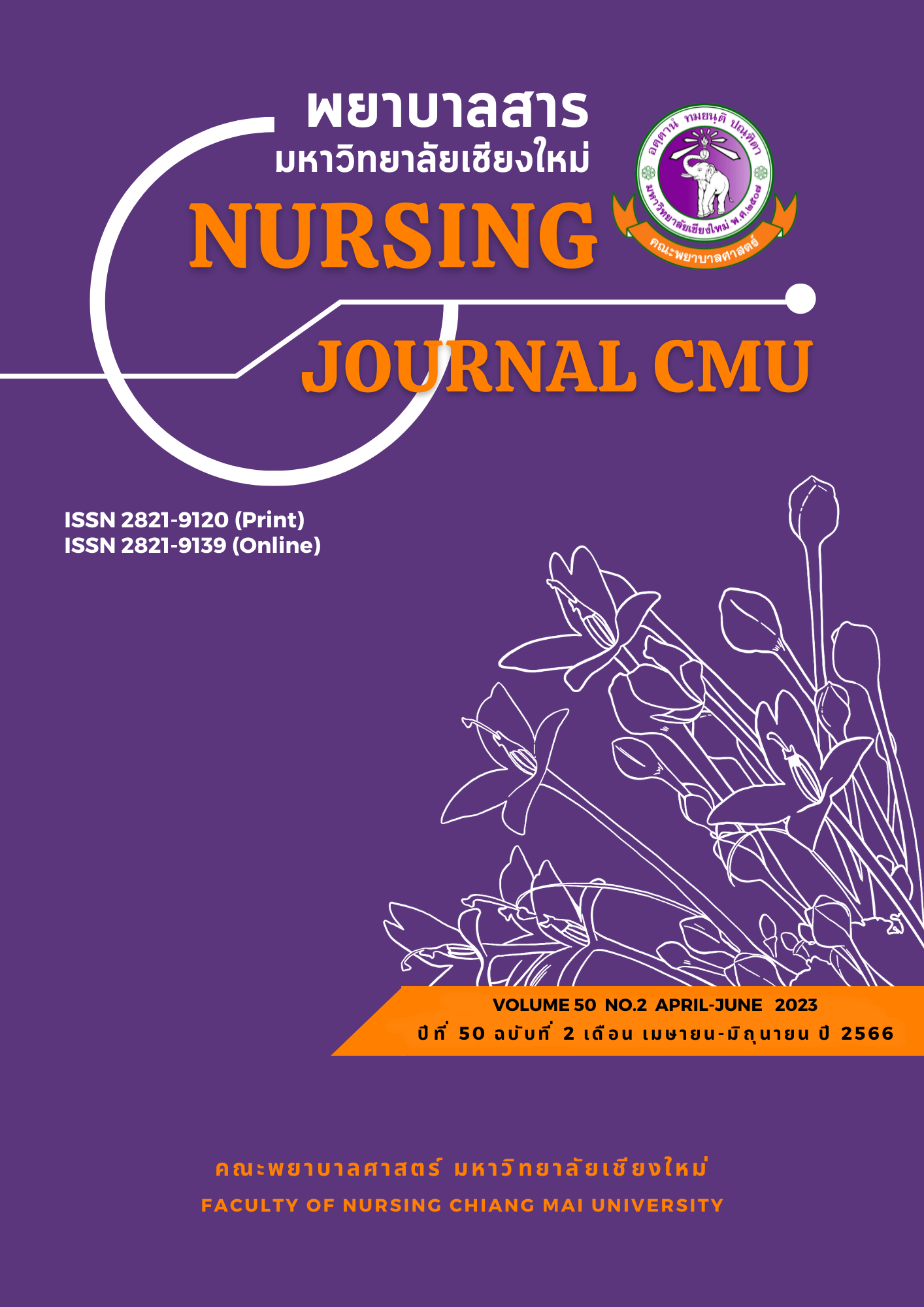Factors Related to Catheter-Associated Urinary Tract Infection Among Acute Stroke Patients in Thammasat University Hospital
Keywords:
Urinary tract infection, Indwelling catheterization, Acute stroke patientsAbstract
Catheter-associated urinary tract infection (CAUTI) is a common complication of acute stroke, resulting in inefficient recovery and increased mortality. A retrospective analytic study was conducted to determine factors associated with CAUTI in 147 stroke patients who were admitted between January 2021-December 2022. The content validity index (CVI) of the data collection form developed by the researcher was 1.0. Statistical analysis included percentage, mean, and standard deviation. Binary logistic regression analysis was used to analyze factors associated with CAUTI.
The study found that factors significantly associated with CAUTI included being female (OR = 1.21, 95% CI: 0.559-2.618, p < .05), being younger (<60 years old) (OR = 0.58, 95% CI: 0.239-1.392, p < .05), being a patient with DM (OR = 2.70, 95% CI: 1.239-5.884), p < .01), the severity of the stroke (NIHSS score 16-42) (OR = 2.93, 95% CI: 1.223-6.996, p < .05), neurological disability (mRS ≥ 4 score) (OR = 1.20, 95% CI: 0.780-6.180, p < .05), a duration of catheterization ≥5 days (OR = 2.38, 95% CI: 1.077-5.243, p < .05), and a fasting blood sugar level ≥ 181 mg% (OR = 5.16, 95% CI: 2.292-11.614, p < .001).
The results of this study can be used to develop a model of care for stroke patients in the acute phase to prevent CAUTI infection and to provide guidelines for further research on predicting factors for CAUTI.
References
Chuang, L., & Tambyah, P. A. (2021). Catheter-associated urinary tract infection. Journal of Infection and Chemotherapy, 27(10), 1400-1406. doi: 10.1016/j.jiac.2021.07.022
Hagerty, T., Kertesz, L., Schmidt, J. M., Agarwal, S., Claassen, J., Mayer, S. A., … Shang, J. (2015). Risk factors for catheter-associated urinary tract infections in critically ill patients with subarachnoid hemorrhage. Journal of Neuroscience Nursing, 47(1), 51-54. Retrieved from https://journals.lww.com/jnnonline/Fulltext/2015/02000/Risk_Factors_for_Catheter_Associated_Urinary_Tract.8.aspx
Hariati, H., Suza, D. E., & Tarigan, R. (2019). Risk factors analysis for catheter-associated urinary tract infection in Medan, Indonesia. Open Access Macedonian Journal of Medical Sciences, 7(19), 3189-3194.
Hill, B. J., Kowalik, C. G., Cohn, J. A., & Dmochowski, R. R. (2019). Cerebrovascular accidents. In L. Liao & H. Madersbacher (Eds.), Neurourology: Theory and practice (pp. 495-498). Dordrecht: Springer Netherlands.
Mukapa, N., Mataruse, A., Ngwende, G. W., & Robertson, V. (2022). Incidence, risk factors and microbiological aetiology of urinary tract infections in admitted stroke patients at a teaching hospital in Zimbabwe: A prospective cohort study. Infection Prevention in Practice, 4(2), 100210. doi: 10.1016/j.infpip.2022.100210
Peach, B. C., Garvan, G. J., Garvan, C. S., & Cimiotti, J. P. (2016). Risk factors for urosepsis in older adults: A systematic review. Gerontology and Geriatric Medicine, 2, 2333721416638980. doi: 10.1177/2333721416638980
Perrin, K., Vats, A., Qureshi, A., Hester, J., Larson, A., Felipe, A., … Busl, K. (2021). Catheter-associated urinary tract infection (CAUTI) in the NeuroICU: Identification of risk factors and time-to-cauti using a case–control design. Neurocritical Care, 34(1), 271-278. doi: 10.1007/s12028-020-01020-3
Retelski, J., Richardson, T., Mahabaleshwarkar, R., Gohs, F. X., & Spencer, M. D. (2017). Retrospective analysis of catheter-acquired urinary tract infection: Relationship to stroke diagnosis. Clinical Nurse Specialist, 31(4), E11-E16. doi: 10.1097/nur.0000000000000307
Rosier, P. F. W. M., Ten Donkelaar, C. S., & de Kort, L. M. O. (2019). Clinical epidemiology: Detrusor voiding contraction maximum power, related to ageing. Urology, 124, 72-77. doi: 10.1016/j.urology.2018.10.038
Shen, S. X., & Liu, Y. (2018). A retrospective study of neuromuscular electrical stimulation for treating women with post-stroke incontinence. Medicine, 97(26), e11264. doi: 10.1097/MD.0000000000011264
Smith, C., Almallouhi, E., & Feng, W. (2019). Urinary tract infection after stroke: A narrative review. Journal of the Neurological Sciences, 403, 146-152. doi: 10.1016/j.jns.2019.06.005
Thammasat University Hospital. (2022). Statistics of stroke patients admitted to Thammasat Hospital. Bangkok: Author.
Tyson, A. F., Campbell, E. F., Spangler, L. R., Ross, S. W., Reinke, C. E., Passaretti, C. L., & Sing, R. F. (2020). Implementation of a nurse-driven protocol for catheter removal to decrease catheter-associated urinary tract infection rate in a surgical trauma ICU. Journal of Intensive Care Medicine, 35(8), 738-744.
Yan, T., Liu, C., Li, Y., Xiao, W., Li, Y., & Wang, S. (2018). Prevalence and predictive factors of urinary tract infection among patients with stroke: A meta-analysis. American Journal of Infection Control, 46(4), 402-409. doi: 10.1016/j.ajic.2017.10.001
Downloads
Published
How to Cite
Issue
Section
License
Copyright (c) 2023 Nursing Journal

This work is licensed under a Creative Commons Attribution-NonCommercial-NoDerivatives 4.0 International License.
บทความที่ได้รับการตีพิมพ์เป็นลิขสิทธิ์ของวารสารพยาบาลสาร
ข้อความที่ปรากฏในบทความแต่ละเรื่องในวารสารวิชาการเล่มนี้เป็นความคิดเห็นส่วนตัวของผู้เขียนแต่ละท่านไม่เกี่ยวข้องกับมหาวิทยาลัยเชียงใหม่ และคณาจารย์ท่านอื่นๆในมหาวิทยาลัยฯ แต่อย่างใด ความรับผิดชอบองค์ประกอบทั้งหมดของบทความแต่ละเรื่องเป็นของผู้เขียนแต่ละท่าน หากมีความผิดพลาดใด ๆ ผู้เขียนแต่ละท่านจะรับผิดชอบบทความของตนเองแต่ผู้เดียว






